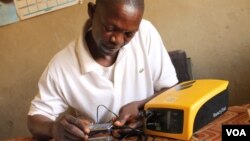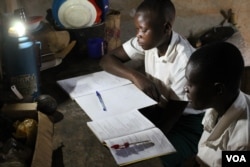KAMPALA —
In Uganda, telecom provider MTN and a company called Fenix are gearing up this year for a nationwide rollout of pre-paid electricity, similar to pre-paid airtime, but using solar kits. Uganda has one of the lowest electrification rates in Africa - a continent where some 600 million people are off the power grid.
The village of Kiwumu lies less than 32 kilometers from the Ugandan capital, Kampala. But the bright lights of the city seem worlds away. Like the vast majority of Uganda, Kiwumu is off the electrical grid, and teacher Michael Mugerwa does not expect things to change any time soon.
"I'm not dreaming of having grid power here in the next 15 years, because power distribution is influenced by government, and government seems to have preference elsewhere. So it's not easy to get grid in these residential communities," he said.
In Kiwumu, says Mugerwa, almost everyone gets their light from kerosene, burned in little tin pots with wicks.
"That's what they use in the whole village here. If you use it for, say, two hours, you get a lot of smoke in your nose," he said.
Plus, he says, kerosene pots just do not provide that much light. So four months ago Mugerwa bought a solar home system with four lights. Now it has become much easier for his students to read and study, he says.
"With this lighting of solar energy the whole room is receiving plenty of light, and as a result many students have moved from their home places. They always come to my place to do evening revision," he said.
Mugerwa's system is called ReadyPay. The company that sells it, Fenix, has teamed up with the telecom provider MTN to create systems that customers can pay off in small installments. A $16 down payment buys several lights and a phone charger, which customers then pay 40 cents a day to use. They can buy anything from a day to a month's worth of light at a time.
Fenix's Chris Bagnall explains that this flexibility means people only have to buy the amount of light they can afford.
"If they have school fees coming in, or they've had an unexpected cost coming in, they can lower their payments. Whereas if they have more income coming in, for example it's harvest time, they can make a larger payment," he said.
Uganda's rate of rural electrification is low - just seven percent. Medard Muganzi of the Rural Electrification Agency, explains that because the population is so spread out, expanding the power grid outside major towns is expensive.
"The costs per connection for the grid is an average of between $2,000 [to] $3,000. In other countries you find these costs can be as low as $700 [or] $800. You're talking about three times, four times the actual cost of distribution because people are just scattered," Muganzi said.
This is why solar systems like ReadyPay are a key part of the national electrification plan, he says. They can provide power in hard-to-reach areas, and in the long run, he says, they are cheaper than the grid for most Ugandans.
"Domestic uses for typical households of ours where the requirement is basically lighting, phone charging, playing small radios - I think solar would be the best option for such a household. It is a utility, but a utility of solar installations, said Muganzi.
Fenix is planning to roll out the ReadyPay across the country within the next few months. In Kiwumu, teacher Mugerwa, for one, is convinced systems like these are cheap enough that families will be lining up to buy them.
"1,000 shillings per day is very little money compared to other utilities. And if I can use it in a family of seven members, then when you divide it becomes very little money," he said.
In the meantime he has opened a small phone-charging business with his solar system, and his wife has bought her very first cell phone. Once you have power, he says, it is hard to go back.
The village of Kiwumu lies less than 32 kilometers from the Ugandan capital, Kampala. But the bright lights of the city seem worlds away. Like the vast majority of Uganda, Kiwumu is off the electrical grid, and teacher Michael Mugerwa does not expect things to change any time soon.
"I'm not dreaming of having grid power here in the next 15 years, because power distribution is influenced by government, and government seems to have preference elsewhere. So it's not easy to get grid in these residential communities," he said.
In Kiwumu, says Mugerwa, almost everyone gets their light from kerosene, burned in little tin pots with wicks.
"That's what they use in the whole village here. If you use it for, say, two hours, you get a lot of smoke in your nose," he said.
Plus, he says, kerosene pots just do not provide that much light. So four months ago Mugerwa bought a solar home system with four lights. Now it has become much easier for his students to read and study, he says.
"With this lighting of solar energy the whole room is receiving plenty of light, and as a result many students have moved from their home places. They always come to my place to do evening revision," he said.
Mugerwa's system is called ReadyPay. The company that sells it, Fenix, has teamed up with the telecom provider MTN to create systems that customers can pay off in small installments. A $16 down payment buys several lights and a phone charger, which customers then pay 40 cents a day to use. They can buy anything from a day to a month's worth of light at a time.
Fenix's Chris Bagnall explains that this flexibility means people only have to buy the amount of light they can afford.
"If they have school fees coming in, or they've had an unexpected cost coming in, they can lower their payments. Whereas if they have more income coming in, for example it's harvest time, they can make a larger payment," he said.
Uganda's rate of rural electrification is low - just seven percent. Medard Muganzi of the Rural Electrification Agency, explains that because the population is so spread out, expanding the power grid outside major towns is expensive.
"The costs per connection for the grid is an average of between $2,000 [to] $3,000. In other countries you find these costs can be as low as $700 [or] $800. You're talking about three times, four times the actual cost of distribution because people are just scattered," Muganzi said.
This is why solar systems like ReadyPay are a key part of the national electrification plan, he says. They can provide power in hard-to-reach areas, and in the long run, he says, they are cheaper than the grid for most Ugandans.
"Domestic uses for typical households of ours where the requirement is basically lighting, phone charging, playing small radios - I think solar would be the best option for such a household. It is a utility, but a utility of solar installations, said Muganzi.
Fenix is planning to roll out the ReadyPay across the country within the next few months. In Kiwumu, teacher Mugerwa, for one, is convinced systems like these are cheap enough that families will be lining up to buy them.
"1,000 shillings per day is very little money compared to other utilities. And if I can use it in a family of seven members, then when you divide it becomes very little money," he said.
In the meantime he has opened a small phone-charging business with his solar system, and his wife has bought her very first cell phone. Once you have power, he says, it is hard to go back.











